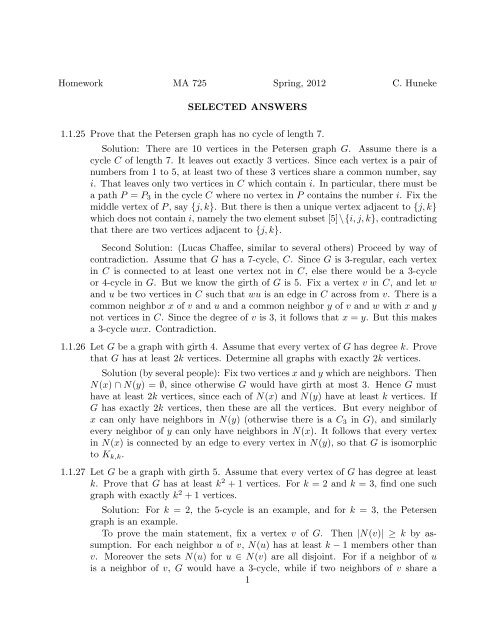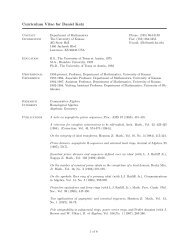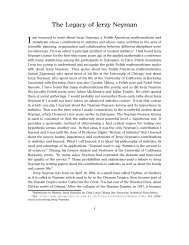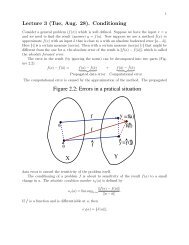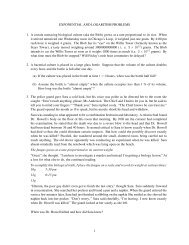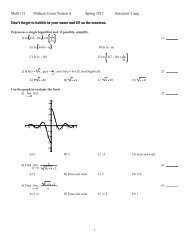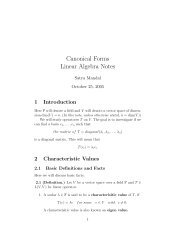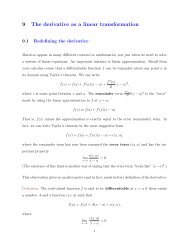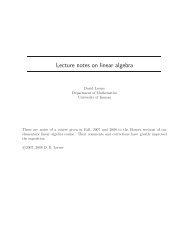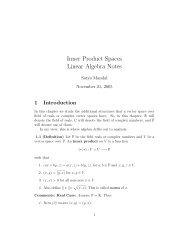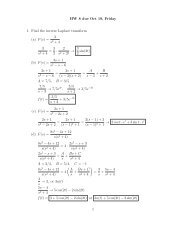Create successful ePaper yourself
Turn your PDF publications into a flip-book with our unique Google optimized e-Paper software.
Homework MA 725 Spring, 2012 C. Huneke<br />
SELECTED ANSWERS<br />
1.1.25 Prove that the Petersen graph has no cycle of length 7.<br />
Solution: There are 10 vertices in the Petersen graph G. Assume there is a<br />
cycle C of length 7. It leaves out exactly 3 vertices. Since each vertex is a pair of<br />
numbers from 1 to 5, at least two of these 3 vertices share a common number, say<br />
i. That leaves only two vertices in C which contain i. In particular, there must be<br />
a path P = P3 in the cycle C where no vertex in P contains the number i. Fix the<br />
middle vertex of P , say {j, k}. But there is then a unique vertex adjacent to {j, k}<br />
which does not contain i, namely the two element subset [5]\{i, j, k}, contradicting<br />
that there are two vertices adjacent to {j, k}.<br />
Second Solution: (Lucas Chaffee, similar to several others) Proceed by way of<br />
contradiction. Assume that G has a 7-cycle, C. Since G is 3-regular, each vertex<br />
in C is connected to at least one vertex not in C, else there would be a 3-cycle<br />
or 4-cycle in G. But we know the girth of G is 5. Fix a vertex v in C, and let w<br />
and u be two vertices in C such that wu is an edge in C across from v. There is a<br />
common neighbor x of v and u and a common neighbor y of v and w with x and y<br />
not vertices in C. Since the degree of v is 3, it follows that x = y. But this makes<br />
a 3-cycle uwx. Contradiction.<br />
1.1.26 Let G be a graph with girth 4. Assume that every vertex of G has degree k. Prove<br />
that G has at least 2k vertices. Determine all graphs with exactly 2k vertices.<br />
Solution (by several people): Fix two vertices x and y which are neighbors. Then<br />
N(x) ∩ N(y) = ∅, since otherwise G would have girth at most 3. Hence G must<br />
have at least 2k vertices, since each of N(x) and N(y) have at least k vertices. If<br />
G has exactly 2k vertices, then these are all the vertices. But every neighbor of<br />
x can only have neighbors in N(y) (otherwise there is a C3 in G), and similarly<br />
every neighbor of y can only have neighbors in N(x). It follows that every vertex<br />
in N(x) is connected by an edge to every vertex in N(y), so that G is isomorphic<br />
to Kk,k.<br />
1.1.27 Let G be a graph with girth 5. Assume that every vertex of G has degree at least<br />
k. Prove that G has at least k 2 + 1 vertices. For k = 2 and k = 3, find one such<br />
graph with exactly k 2 + 1 vertices.<br />
Solution: For k = 2, the 5-cycle is an example, and for k = 3, the Petersen<br />
graph is an example.<br />
To prove the main statement, fix a vertex v of G. Then |N(v)| ≥ k by assumption.<br />
For each neighbor u of v, N(u) has at least k − 1 members other than<br />
v. Moreover the sets N(u) for u ∈ N(v) are all disjoint. For if a neighbor of u<br />
is a neighbor of v, G would have a 3-cycle, while if two neighbors of v share a<br />
1
2<br />
common neighbor other than v, G would have a 4-cycle. Hence there are at least<br />
1 + k + k(k − 1) = k 2 + 1 vertices.<br />
1.1.28 Prove that the girth of the odd graph Ok is 6 if k ≥ 3.<br />
Solution: We show that there is no 5-cycle. Proving there are no 4 or 3 cycles<br />
is easier. Assume by way of contradiction that there is a 5-cycle, say with vertices<br />
a, b, c, d, e and edges ab, bc, cd, de, ea. Without loss of generality, a = {k +2, ..., 2k +<br />
1}. Then both b and e must be k-element subsets of {1, ..., k + 1}. In particular,<br />
they must share k − 1 elements. Since a is arbitrary, this argument proves that<br />
any two vertices which share a common neighbor in the 5-cycle must have k − 1<br />
elements in common. In particular a and d share k − 1 elements and a and c share<br />
k−1 elements. Since a is a k-element set, it follows that d and c must share at least<br />
k − 2 elements. But they are neighbors, hence disjoint. It follows that k − 2 ≤ 0.<br />
This contradicts the assumption that k ≥ 3.<br />
To prove there is a cycle of length 6, do this as I did in class. First write an<br />
explicit 6-cycle when k = 3. Then divide the remaining 2k +1−7 = 2k −6 into two<br />
disjoint sets S and T , and attach them to the 6-cycle written down for k = 3 by<br />
alternating them among the vertices. This gives an example of a 6-cycle in general.<br />
Section 1.2<br />
1.2.20 Let v be a cut-vertex of a simple graph G. Prove that G − v is connected.<br />
Solution: This is done as we discussed in class. Let x and y be vertices of G − v.<br />
If they lie in different connected components of G − v, then they are adjacent in<br />
G − v. If not, since G − v has at least two components, choose a vertex z in a<br />
different component than the one containing both x and y. In G − v, xz is an edge,<br />
as well as yz. Hence there is a path from x to y in G − v.<br />
1.2.24 Let G be a simple graph having no isolated vertex and no induced subgraph with<br />
exactly two edges. Prove that G is a complete graph.<br />
Solution: (several people): First observe that G must be connected; if not, then<br />
since it has no isolated vertices the connected components must each contain at<br />
least one edge. But two edges in two different connected components contradicts<br />
the assumption that no induced subgraph has exactly two edges.<br />
If G has two vertices that are not adjacent, then there is a shortest path connecting<br />
them of length at least two. Then any three consecutive vertices along this<br />
path would induce a subgraph with exactly two edges, contradiction.<br />
1.2.29 Let G be a connected simple graph not having P4 or C3 as an induced subgraph.<br />
Prove that G is a biclique. (That is, isomorphic to a complete bipartite graph.)<br />
Solution. We first prove that G is bipartite. It suffices to prove that G has no<br />
odd cycles. Suppose G does have an odd cycle, say C2k+1. Choose k smallest. By<br />
assumption, k ≥ 2. In that case the cycle contains a P4 subgraph, which cannot
e an induced subgraph. It therefore has a chord, which will lead to a smaller odd<br />
cycle, contradiction. Hence G is bipartite.<br />
We prove that G is complete. Let X and Y denote the sets of vertices which<br />
realize G as a bipartite graph, and let x ∈ X, y ∈ Y . If xy is not an edge, choose<br />
the shortest path between them (G is connected.) Since G is bipartite, this path<br />
must contain an induced P4, contradiction.<br />
1.2.30 Let G be a simple graph with vertices v1, . . . , vn. Let A = (aij) be the adjacency<br />
matrix of G. Prove that (A k )ij is the number of vi, vj walks of length K in G.<br />
Solution: Induct on k. For k = 2, note that (A 2 )ij = <br />
k ailalj, and a term in<br />
this sum is nonzero if and only if ail = 0 and alj = 0, in which case both are one,<br />
and their product is one. Thus the sum counts the number of nonzero terms in the<br />
sum. But a term is nonzero if and only if vivlvj is a walk in G. This proves the<br />
case k = 2.<br />
The general case follows by induction. Set A k−1 = (bij). By induction bij is the<br />
number of vi, vj walks of length k − 1. The ij th entry of A k is <br />
l bilalj. A term<br />
is nonzero in this sum if and only if there is a walk of length k − 1 from vi to vl<br />
and an edge vlvj, and in this case that term counts the number of walks of length<br />
k from vi to vj whose next to last step is vl. Summing over all l then counts the<br />
total number of walks from vi to vj of length k.<br />
1.2.40 Let P and Q be paths of maximum length in a connected graph G. Prove that P<br />
and Q have a common vertex.<br />
Solution: (several people) Set the length of these paths to be m. If their vertices<br />
are disjoint, then fixing any two vertices, one in P and one in Q, there is a path<br />
from one to the other. Choose a vertix x ∈ P , and a vertex y ∈ Q such that the<br />
path from x to y is the shortest among all such paths. The length of a path P ′<br />
from x to the furthest endpoint of P is at least m,<br />
and similarly the length of a<br />
2<br />
path Q ′ from y to the furthest endpoint of Q is at least m<br />
2 . Using the shortest path<br />
from x to y and combining it with the paths P ′ and Q ′ gives a path of length more<br />
than m, contradiction.<br />
Section 1.3<br />
1.3.12 Prove that an even graph has no cut-edge. For each k ≥ 1, construct a (2k + 1)regular<br />
simple graph having a cut-edge.<br />
Solution (Ilya Smirnov): We know that an even graph decomposes into cycles.<br />
Moreover, we know a edge is a cut-edge if and only if it belongs to no cycle. Hence<br />
even graphs have no cut-edges.<br />
To construct the required graph, start with K2k+2. Choose k pairs of vertices<br />
from this graph, say x1, ..., xk and y1, ..., yk. Remove the edges xiyi from K2k+2,<br />
for i = 1, ..., k. The resulting graph has 2k vertices of degree 2k, and 2 vertices of<br />
degree 2k + 1. Finally add one new vertex z, and edges zxi and zyi. This gives a<br />
3
4<br />
graph G with one vertex (namely z) of degree 2k, and all other vertices of degree<br />
2k + 1. Now take two disjoint copies of G, say G and G ′ , and add one edge joining<br />
z and z ′ . This edge is a cut-edge, and the graph is (2k + 1)-regular.<br />
1.3.14 Prove that every simple graph with at least two vertices has two vertices of equal<br />
degree.<br />
Solution: Suppose there are n vertices. The degrees of the vertices are integers<br />
between 0 and n − 1. The Pigeon-Hole principle shows that two have the same<br />
degree unless the degrees of the n vertices are exactly the integers between 0 and<br />
n − 1. But this is impossible since a vertex of degree n − 1 is connected to every<br />
vertex, so there could not be a vertex of degree 0 in this case.<br />
1.3.15 For each k ≥ 3, determine the smallest n such that<br />
a) there is a simple k-regular graph with n vertices.<br />
b) there exist nonisomorphic simple k-regular graphs with n vertices.<br />
Solution, a): Clearly n ≥ k +1 since G is simple; otherwise the maximum degree<br />
of a vertex would be at most k − 1. On the other hand there is a k-regular simple<br />
graph with k + 1 vertice, namely Kk+1. Hence n = k + 1 is the smallest number of<br />
vertices for which there exists such a graph.<br />
Solution, b) (several people): It is simplest to think in terms of the complement<br />
of such graphs. A simple graph G with n vertices is k-regular if and only if G is<br />
n − 1 − k-regular. Moreover the complement of two simple graphs are isomorphic if<br />
and only if the graphs are isomorphic. Consider then the complement. If n = k +1,<br />
G is 0-regular, i.e., a set of isolated points. Hence the only k-regular graph having<br />
k + 1 vertices is Kk+1, the complement of isolated points. If n = k + 2, then the<br />
complement is a 1-regular graph on n vertices. There are no such graphs if n is<br />
odd by the degree-sum formula, while if n is even, the only such graph is a disjoint<br />
union of edges. Since this is unique, there is at most one graph which is k-regular<br />
with k + 2 edges. However, if we take n = k + 3, then there are at least two<br />
non-isomorphic simple 2-regular graphs having k + 3 vertices, for example, Ck+3<br />
and the disjoint union of C3 and Ck (note k ≥ 3). Thus n = k + 3 is the answer.<br />
1.3.18 For k ≥ 2, prove that a k-regular bipartite graph has no cut edge.<br />
Solution: Since every component of a k-regular bipartite graph is also k-regular<br />
and bipartite, we may assume that G is connected without loss of generality. Suppose<br />
G has a cut edge e. Let G1 and G2 be the two connected components of G−e.<br />
Consider one of them, G1, which will contain one of the vertices incident to e, say<br />
u. G1 is still bipartite. Denote the two disjoint vertex sets as X and Y , so that<br />
every edge of G1 goes between vertices in X and vertices in Y . Let n(X) = p and<br />
n(Y ) = q. Every vertex has degree k except for u, which has degree k − 1. We<br />
count the number of edges in two ways; if u ∈ X, then there are k(p − 1) + (k − 1)
edges going from X to Y , which is exactly kp − 1. But counting the same edges as<br />
going from Y to X, there must be qk. Since k ≥ 2, this is impossible.<br />
1.3.26 Count the number of 6-cycles in Q3. Prove that every 6-cycle in Qk (k ≥ 3) lies in<br />
exactly one three-dimensional subcube. Use this to count the number of 6-cycles<br />
in Qk.<br />
Solution: By either brute force or clever counting, one finds there are 16 6-cycles<br />
in Q3. Notice that in a 6-cycle in Qk, edges correspond to changing the entry in<br />
exactly one position. Since one has to return back to the start, each time a position<br />
is changed, it must be eventually changed back. Hence there must be exactly three<br />
positions which change, and the other k−3 remain fixed. Since these other positions<br />
can be fixed arbitrarily, and there are k<br />
3 choices of the three dimensional subcube,<br />
there are exactly 16 k k−3<br />
3 2 6-cycles.<br />
Section 1.4<br />
1.4.8 Prove that there is an n-vertex tournament with indegree equal to outdegree at<br />
every vertex if and only if n is odd.<br />
Solution (Nick Packauskas and others): Let G be an n-vertex tournament with<br />
indegree equal to outdegree at every vertex. Then n cannot be even since for every<br />
vertex v, d + (v) + d − (v) = n − 1 is odd.<br />
We prove the converse by induction. It is clear for n = 1. Let n > 1 and<br />
suppose there an (n − 1)-vertex tournament H with indegree equal to outdegree at<br />
every vertex. Partition V (H) into two sets, X and Y , of cardinalities n and n − 1<br />
respectively. Add two new vertices u, v to H. Add edges going from u to each<br />
vertex in X, from each vertex of X to v, from v to each vertex in Y , and from each<br />
vertex of Y to u. This does it.<br />
1.4.10 Prove that a digraph is strongly connected iff for each partition of the vertex set<br />
into nonempty sets S and T , there is an edge from S to T .<br />
Solution (Lucas Chaffee, similar to several others): We first prove the forward<br />
direction. For an arbitrary partition S and T , let u ∈ S and v ∈ T . By the strong<br />
connectedness, there exists a directed path from u to v, and so at some point we<br />
traverse an edge from S to T .<br />
Converse: For an arbitrary x ∈ V (G), let S be all vertices reachable by x with a<br />
directed path. If S were not all of V (G), then by hypothesis there’s an edge from<br />
S to the complement of S in V (G), meaning x can reach it, a contradiction. Hence<br />
S = V (G), and since x was arbitrary, G is strongly connected.<br />
Section 2.1<br />
2.1.6 Let T be a tree with average degree a. In terms of a, determine n(T ).<br />
5
6<br />
Solution: By definition, a =<br />
P d(v)<br />
n<br />
vertices. By the degree-sum formula we obtain that a =<br />
, where n = n(T ), and the sum is over all<br />
2e(T )<br />
n . Since T is a tree,<br />
e(T ) = n − 1. Hence a = 2(n−1)<br />
n . Solving for n in terms of a yields n = 2<br />
2−a .<br />
2.1.26 For n ≥ 3, let G be an n-vertex graph such that every graph obtained by deleting<br />
one vertex is a tree. Determine e(G), and use this to determine G itself.<br />
Solution: (Nick Packauskas) We claim that G is isomorphic to Cn. Let Gi =<br />
G − vi, where V (G) = {v1, ..., vn}. Each Gi is a tree and thus has n − 2 edges.<br />
As there are n such subgraphs, the number of total edges in all these subgraphs is<br />
n(n − 2). Each edge in G has two endpoints, and is therefore counted in exactly<br />
n − 2 of the edge count in the subgraphs. Thus e(G) = n. It follows that G has<br />
a cycle. But none of the Gi have a cycle, so the cycle must include every vertex.<br />
Thus G is an n-cycle.<br />
2.1.29 Every tree is bipartite. Prove that every tree has a leaf in its larger partite set,<br />
and in both if they have equal size.<br />
Solution (Rajib Anwar and others): Let A and B be two partite sets of a tree T<br />
such that |A| ≥ |B|. If there is no leaf in A, then since every vertex in A will have<br />
degree at least two, e(T ) ≥ 2|A| ≥ |A| + |B| = n(T ) = e(T ) + 1, a contradiction. If<br />
|A| = |B|, the same argument shows that both have leaves.<br />
2.1.37 Let T and T ′ be two spanning trees of a connected graph G. For e ∈ E(T ) \ E(T ′ ),<br />
prove there is an edge e ′ ∈ E(T ′ ) \ E(T ) such that T − e + e ′ and T ′ − e + e ′ are<br />
both spanning trees of G.<br />
Solution (Khaled Alhazmy and others): Since T is a tree, we know that e is a<br />
cut-edge of T . Thus T − e has two connected components, say T1 and T2, both of<br />
which are trees as well. Let e = xy, with x ∈ T1 and y ∈ T2. There is a unique<br />
x − y path in T ′ (either by (2.1.4D) or the fact that T ′ + e contains a unique cycle),<br />
and hence this path contains an edge e ′ which connects T1 to T2. Clearly e ′ /∈ T ,<br />
else T contains a cycle. Now T − e + e ′ is connected with n(G) − 1 edges and is<br />
therefore a spanning tree. Likewise T ′ − e ′ + e has n(G) − 1 edges and no cycles,<br />
and is therefore a tree.<br />
Section 2.2<br />
2.2.1 Determine which trees have Prüfer codes that (a) contain only one value, (b) contain<br />
exactly two values, or (c) have distinct values in all positions.<br />
Solution: (a) This means that one vertex is adjacent to all other vertices, so the<br />
graph is K1,n for some n.<br />
(b) With two values in the code, we know there are exactly two vertices which<br />
are not leaves. Therefore the graph has two vertices with leaves coming out from<br />
each of them.<br />
(c) With distinct values in all positions, there are only two leaves in the tree.<br />
Therefore the tree must be a path.
2.2.10 Compute τ(K2,m). Also compute the number of isomorphism classes of spanning<br />
trees of K2, m.<br />
Solution 1 (Farhana Abedin, similar to several): Let X be the vertex set on two<br />
elements, and Y the other vertex set on m-elements. Each spanning tree of K2,m<br />
has a unique vertex in Y which is a common neighbor of the vertices in X, and<br />
this common neighbor can be chosen in m ways. The remaining vertices in Y form<br />
leaves. For each leaf we can choose its neighbor in X in one of two ways. Hence<br />
the number of spanning trees is exactly m2 m−1 .<br />
Vertices in X possess one common neighbor in Y . The leaves are distributed<br />
among the vertices in X to determine the isomorphism classes. We can connect<br />
z leaves to one vertex and m − 1 − z leaves to the other vertex, where 0 ≤ z ≤<br />
⌊(m − 1)/2⌋. Hence there will be ⌊(m + 1)/2⌋ total isomorphism classes.<br />
2.2.25 Prove that if a graph G is graceful and Eulerian, then e(G) is congruent to 0 or 3<br />
mod 4.<br />
Solution (Peidi Gu, similar to others): Let f be a graceful labelling of G which<br />
we assume has m + 1 vertices. The parity of the sum of the labels of an edge is the<br />
same as the parity of the absolute value of their difference, and therefore the sum<br />
of the absoute values of the differences of the labels, which is m<br />
( m + 1)/2 since the<br />
labels are from 1 to m, is congruent mod 2 to <br />
v∈V (G) d(v)f(v). As G is Eulerian,<br />
each d(v) is even, so the sum is even. It follows that 4 divides m(m + 1), and the<br />
problem follows at once.<br />
Section 2.3<br />
2.3.1 Assign integer weights to the edge of Kn. Prove that the total weight on every<br />
cycle is even if and only if the total weight on every triangle is even.<br />
Solution (CJ Harries, similar to several): One direction is trivial: if every cycle<br />
has total weight even, obviously every triangle has total weight even. For the<br />
converse, use induction on the size m of the cycle. We can assume m ≥ 4. Choose<br />
a path P3 within the cycle C, say with edges e and f, and endpoints u and v. By<br />
induction the cycle formed by deleting e and f and replacing them with the edge<br />
g = uv has even total weight. Moreover, w(e) + w(f) = w(g) modulo 2. Letting<br />
W be the sum of the weights of the the edges of C − e − f, we have that the total<br />
weight of C is w(e) + w(f) + W ≡ w(g) + W ≡ 0 modulo 2.<br />
2.3.7 Let G be a weighted connected graph with distinct edge weights. Without using<br />
Kruskal’s algorithm, prove that G has a unique minimum weight spanning tree.<br />
Solution (Lucas Chaffee): Assume that there are two distinct minimal weight<br />
spanning trees, T and T ′ . By problem 2.1.37, there are edges e of T and e ′ of T ′<br />
such that both T − e + e ′ and T ′ − e ′ + e are spanning trees. Since one of e or e ′ has<br />
strictly smaller weight than the other, one of these trees has smaller weight than<br />
T or T ′ , contradiction.<br />
7
8<br />
Section 3.1<br />
3.1.5 Prove that α(G) ≥ n(G)<br />
∆(G)+1 for every graph G.<br />
Solution: Let X be an independence set of G of size α(G) = a. There are at most<br />
∆(G) neighbors for each element of X, and since X is maximum, G ⊂ X ∪ NG(X).<br />
Hence n ≤ a + ∆(G)a, implying the result.<br />
3.1.8 Prove or disprove: Every tree has at most one perfect matching.<br />
Solution (several people): Some did this by induction. But I think the nicest<br />
solution is the following: Assume that M and M ′ are perfect matching of a tree,<br />
and consider their symmetric difference F . Every vertex in F has degree 0 or 2,<br />
which implies that every connected component of F is either an isolated vertex or<br />
a cycle. Since T has no cycles, F is a collection of isolated vertices. This means<br />
every edge in M is an edge in M ′ , and vice-versa, so M = M ′ .<br />
Section 4.1<br />
4.1.5 Let G be a connected graph with at least three vertices. Form G ′ from G by adding<br />
an edge with endpoints x, y whenever dG(x, y) = 2. Prove that G ′ is 2-connected.<br />
Solution: Since n(G) > 2, it suffices to prove that G has no cut-vertex. Let<br />
x ∈ G ′ . If G ′ − x is disconnected, then obviously so is G − x. Let u and v be in two<br />
different components of G − x. Since G is connected, there is a path in G between<br />
these two vertices which necessarily must go through x. Let a and b be the two<br />
vertices nearest x on this path. Then dG(a, b) = 2, so that a and b are connected<br />
in G ′ . It follows that G ′ − x is not disconnected, a contradiction.<br />
4.2.4 Prove or disprove: If P is a u, v path in a 2-connected graph G, then there is a<br />
u, v-path Q that is internally disjoint from P .<br />
Solution: This is false. A counterexample is given by K4 minus any edge.<br />
4.2.12 Use Menger’s theorem to prove that κ(G) = κ ′ (G) when G is 3-regular.<br />
Solution (L. Chaffee): Let S ⊂ V (G) be a set which separates X, Y ⊂ V (G) with<br />
|S| = κ(G), and let F = [H, H ′ ] with |F | = κ ′ (G). Note that either X ∩ H = ∅ and<br />
Y ∩ H ′ = ∅ or X ∩ H ′ = ∅ and Y ∩ H = ∅, or both. Without loss of generality, let<br />
x ∈ X ∩ H and y ∈ Y ∩ H ′ . By Menger’s theorem 4.2.19, we have that κ ′ (G) is the<br />
maximum number of edge disjoint x, y-paths. These edge disjoint paths must be<br />
internally disjoint, else the common vertex would have degree at least four, and so<br />
there are at least κ ′ (G) internally disjoint x, y-paths as well. By the other version<br />
of Menger’s theorem, 4.2.17, we have that the minimum size of a x, y disconnecting<br />
set is at least κ ′ (G), and therefore κ(G) ≥ κ ′ (G). Since we always have the other<br />
inequality, they must be equal.


